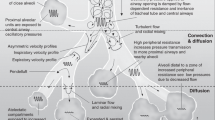Abstract
High frequency ventilation (HFV) is a mode of therapy that improves gas exchange with pressure fluctuations much lower than that required for conventional ventilation. HFV is efficacious in the ‘rescue’ management of infants with respiratory failure. Although each HFV system has functional characteristics that are design related, it now appears that when used with similar treatment strategies and within functional limitations, similar outcomes can be achieved. Ideally, the clinician or the operator should be familiar with the basic concepts of different high frequency ventilators to achieve maximal benefits from using these devices in infants with respiratory failure.
Similar content being viewed by others
References
Kirby RR, Robinson E, Schulz J, deLemos RA. Continuous flow ventilation as an alternative to assisted or controlled ventilation in infants.Anesth Analg 1972; 51: 871–875.
Kirby RR. Intermittent mandatory ventilation in the neonate.Crit Care Med. 1977; 5: 18–22.
Hall RT, Rhodes PG. Pneumothorax and pneumomediastinum in infants with idiopathic respiratory distress syndrome receiving continuous positive airway pressure.Pediatrics 1975; 55:493–496.
Bhutani VK and Abbasi S. Long-term pulmonary consequences in survivors with bronchopulmonary dysplasia.Clin Perinatol 1992; 19 (3): 649–671.
Ramanathan R, Mason GR, Raj JU. Effect of mechanical ventilation and barotrauma on pulmonary clearance of 99m-Technetium diethylenetriamine penta-acetate in lambs.Pediatr Res 1990; 27: 70–74.
Dreyfuss D, Soler O, Basset Get al. High inflation pressure pulmonary edema. Respective effects of high airway pressure, high tidal volume and positive end-expiratory pressure.Am Rev Respir Dis 1988; 137: 1159–1164.
Chang HK. Mechanisms of gas transport during ventilation by high-frequency oscillation.J Appl Physiol 1984; 56: 553–563.
Hariis TR, Bunnell JB. High-frequency jet ventilation in clinical neonatology. In : Pomerance JJ, Richardson CJ (eds).Neonatology for the Clinician. Appleton & Lange, 1993:311–324.
Haselton FR, Scherer PW. Bronchial bifurcation and respiratory mass transport.Science 1980; 208: 69–71.
Gerstmann D, Fouke D, Winter A, Taylor A, deLemos RA. Proximal, tracheal and alveolar pressures during highfrequency ventilation in a normal rabbit model.Pediatr Res 1990; 28:367–373.
Pillow JJ, Neil H, Wilkinson MH, Ramsden CA. Effect of I/ E ratio on mean alveolar pressure during highfrequency oscillatory ventilation.J Appl Physiol 1999; 87:407–414.
Boynton BR, Villanueva D, Hammond MDet al. Effect of mean airway pressure on gas exchange during high frequency oscillatory ventilation.J Appl Physiol 1991; 70 (2): 701–707.
Meredith KS, deLamos RA, Coalson JJet al. Role of lung injury in the pathogenesis of hyaline membrane disease in premature babboons.J Appl Physiol 1989; 66:2150–2158.
DeLemos RA, Coalson JJ, Gerstmann DRet al. Ventilatory mangement of infant baboons with hyaline membrane disease. The use of high frequency ventilation.Pediatr Res 1987; 21:594–602.
The HIFI Study Group. High-frequency oscillatory ventilation compared with conventional mechanical ventilation in the treatment of respiratory failure in preterm infants.N Eng J Med 1989; 320:88–93.
HIFI Study Group. High-frequency oscillatory ventilation compared with conventional mechanical ventilation in the treatment of respiratory failure in preterm infants: Neurodevelopmental status at 16 to 24 months of post term age.J Pediatr 1990; 117: 939–946.
Clark RH, Gerstmann DR, Null DM, deLemos RA. Prospective randomized comparison of high frequencyoscillatory ventilation and conventional ventilation in respiratory distress syndrome.Pediatrics 1992; 89:5–11.
Ogawa Y, Miyasaka K, Kawano Tet al. A multicenter randomized trial of high frequency oscillatory ventilation as compared with conventional ventilation in preterm infants with respiratory failure.Early Hum Dev 1993; 32:1–10.
Carlo WA, Chatburn RL, Martin RJet al. Decrease in airway pressure during high-frequency jet ventilation in infants with respiratory distress syndrome.J Pediatr 1984; 104:101–107.
Carlo WA, Siner B. Chatburn RL. Robertson S, Martin RJ. Early randomized intervention with high frequency jet ventilation in respiratory distress syndrome.J Pediatr 1991; 119: 765–770.
Gerstmann DR, Minton SD, Stoddard RA,et al. The Provo multicenter early high-frequency oscillatory ventilation trial: Improved pulmonary and clinical outcome in respiratory distress syndrome.Pediatrics 1996; 98:1044–1057.
Carter JM, Gerstmann DR, Clark RHet al. High frequency oscillatory ventilation and extracorporeal membrane oxygenation for the treatment of acute neonatal respiratory failure.Pediatrics 1990; 85: 159–164.
Clark RH, Yoder BA, Sell MS. Prospective randomized comparison of high-frequency oscillation and conventional ventilation in condidates for extracorporeal membrane oxygenation.J Pediatr 1994:124:447–454.
Author information
Authors and Affiliations
Corresponding author
Rights and permissions
About this article
Cite this article
Ramanathan, R., Sardesai, S. High frequency ventilation : Basic concepts and clinical application. Indian J Pediatr 67, 3–8 (2000). https://doi.org/10.1007/BF02802623
Issue Date:
DOI: https://doi.org/10.1007/BF02802623




